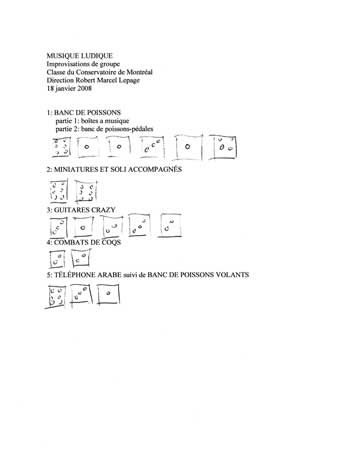
Robert Lepage
Jeu de dés
Listen to an excerpt from an improvisation played using the dice game. Performed by Émilie Girard-Charest (bass), Laurence Latreille-Gagné (horn), Gabrielle Gingras (synthesizer), Marc Antoine Bérubé (flat drum), Sarah Bérubé-Lalancette (trombone), Guillame Garant-Rousseau (tuba), Robert Marcel Lepage (clarinet), Pierre Alexandre Maranda (doublebass).

Robert Marcel Lepage created his dice game in 2006 as a means of conceptualising and exploring improvised music. The dice game stems from Lepage’s first experiments with improvising games. Notably, Lepage saw a close musical affinity between Japanese haiku poetry and improvised music with respect to the launching of poetic images or musical phrases within a predetermined framework. Since his first encounters with improvisation, Lepage has always felt a rapport between the iconography of dice and improvised music in terms of the element of chance and the spontaneity involved in launching numerical or musical propositions in the moment. Thus, dice were the obvious choice for serving as a pedagogical tool for teaching the basics of improvised music.
Musical Parameters
Lepage’s game features six dice arranged into three groups of two, and one white cube. There are two ways of reading the dice: either as a soloist practising alone, or as a group improvising together. Lepage divides the music into three parameters: basic musical materials, musical time, and the interaction between the individual and the group. Each face of each dice is assigned a particular element of a given parameter of the music. In general, the elements correspond to the numbers 1-6 in terms of their relative degrees of complexity, where 1 represents the most simple musical element and 6 represents the most complex in a given parameter. The first pair of dice represents the basic musical materials. It is divided into the material itself (e.g. “texture”) and the axis along which it is to be developed (e.g. “in a continuous manner”). The second pair represents first, musical time with respect to the articulation of the material (e.g. at “regular” or “irregular” intervals of time), and second, the form. Finally, the third pair represents the interaction between the individual and the group, only used in the context of a group session.
Lepage’s Purpose
Usually the game is played with one or two pairs of dice at a time because it is very difficult to work with all three pairs at the same time. The white cube represents silence for breaking the flow in the context of a group. Lepage’s principle purpose is neither to create a means of systematising improvised music, nor even to suggest that his game be used as a tool for creating improvised musical structures. Rather, the dice game provides a means for practising improvisation and transgressing traditional musical boundaries.
 English |
English |